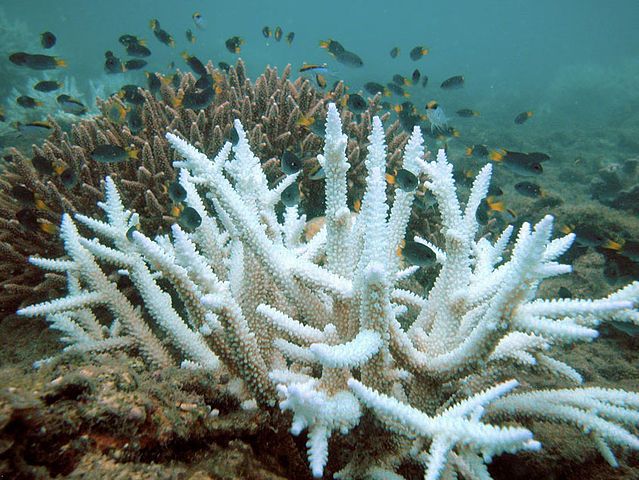Coral Bleaching in a Warming World
Published on by Rituraj Phukan, Chief Operating Officer at Walk For Water in Academic
At last there is some good news for coral reefs. The worst ever coral bleaching event in history, which lasted over three years and had destroyed coral reefs all over the world appears to be coming to an end.

In Australia, the Great Barrier Reef was devastated by the worst bleaching event in 2016 and then again in 2017, killing half of the largest living thing on earth. In the Indian Ocean, the Maldives had almost all of its reefs affected, with 60% to 90% of coral colonies bleached.
The Australian territory of Christmas Island was devastated with 85% of coral reefs dead and 100% affected. The situation is equally grim in the Lakshadweep archipelago, but it has not received as much focus as the bleaching events down under.
Corals are the ocean’s richest biome and are vulnerable to changes in temperature, light and nutrients. According to reports, up to three-quarters of the existing reefs are likely to disappear by 2050 due to climate change impacts. In the Indian ocean nearly seventy percent of coral reefs appear to have died.
Inhabiting the world’s tropical seas, coral reefs are habitat to millions of marine species. Corals have a symbiotic relationship with microscopic algae or zooxanthellae that live in their tissue, and provide much of the energy requirement of the corals.
The brown and green colors of most corals come from the zooxanthellae; in shallow waters brighter pigments of blue, pink and yellow mask these. Even minor temperature rises of 1 to 2°C above normal leads to stress and breakdown of the relationship. With the loss of algae, the coral tissues become transparent and the bright white of the underlying coral skeleton gives it the appearance of bleaching.
Without the energy supplied by the zooxanthellae, many corals starve to death and become vulnerable to disease. In many locations around the world, high temperatures have caused severe mass bleaching events leading to widespread death of corals and long lasting reef damage.
Additionally, acidification of the oceans reduces the amount of calcium carbonate available for corals and other calcifying marine organisms to build their skeletons and shells. There is little that can be done to reverse the process and the only way to reduce ocean acidification globally is to reduce CO2 concentrations in the atmosphere.
A recent European research has indicated that limiting warming to 1.5°C would provide a window of opportunity for some tropical coral reefs to adapt to climate change. In contrast, a 2°C temperature increase by 2100 would put virtually all of these ecosystems at risk of severe degradation due to coral bleaching. Hopefully, world leaders will soon realize that we are continuously shrinking the window of opportunity we have to avert catastrophic warming impacts on the planet.
Media
Taxonomy
- Environment
- Ecosystem Management
- Marine
- Climate Change
- Environmental Impact Assessment
- Oceanographic Survey
- Environment
2 Comments
-
You make assumptions that can not be proven. The temperatures have not risen. Gail Work suggests that destruction of coral reefs are related to pollution. I agree with her assessment.
The purpose of so called global warming theories is political. It is a tool used by governments to control energy and the populus. It is fraudulent science.
1 Comment reply
-
Go to the website of One Earth Ventures, where Gail Work is the founder and CEO. It might be educational.
-
-
Our One Earth Ventures team did a field study last year in Mexico and proved out a coral reef restoration process that demonstrated the ability to turn around a dead coral reef quickly using all natural treatments. We treated the reef by first remediating the water running off a golf course that was polluting the corals, then we treated using micronutrients and increased the fish population by 800-1,000%, brought back hard corals, soft corals, sponges and algae in 5 weeks. The Coral Triangle in Malaysia is of particular interest to us given the species of corals there, we would like to connect with Malaysian sponsors to do a field trial in that region or other regions to start addressing this serious threat. In addition we have developed a treatment for plastics in the ocean to treat down to the microbeads and are seeking sponsors to do pilots on this new technology. We expect to be in India later on this year and are addressing an initiative in the Tamil Nadu coastal area for coral reef restoration and are also looking to address the Red Sea area. Please contact me if you have initiatives or sponsors for these types of solution.
Gail Work, CEO - One Earth Ventures gwork@oneearthventures.com
3 Comment replies
-
I'm keen to hear about your work, so email sent Gail. Regards Rod
-
Hi Gail, just checked your website and realized there is scope of collaborative work in the field of water.
Warm regards,
Raj
Rituraj Phukan
Chief Operating Officer
II Walk For Water II www.walkforwater.in II
II raj.phukan@walkforwater.in II +91 9435060642 IIMentor & District Manager, The Climate Reality Project India
Secretary General, Green Guard Nature Organization
Assam Coordinator, Kids For TigersMember, International Antarctic Expedition 2013
-
You are doing amazing work! I would love to read, write about or share published stories about these restorations. Please mail me on rrajphukan@gmail.com and connect on Facebook if you would like to. https://www.facebook.com/rrajphukan While in India, you might want to connect with Rohan Arthur of the NCF, who have been studying the coral reefs in Lakshadweep for years and could provide data on bleaching and restoration works in India. He can be reached at rohan@ncf-india.org .
-